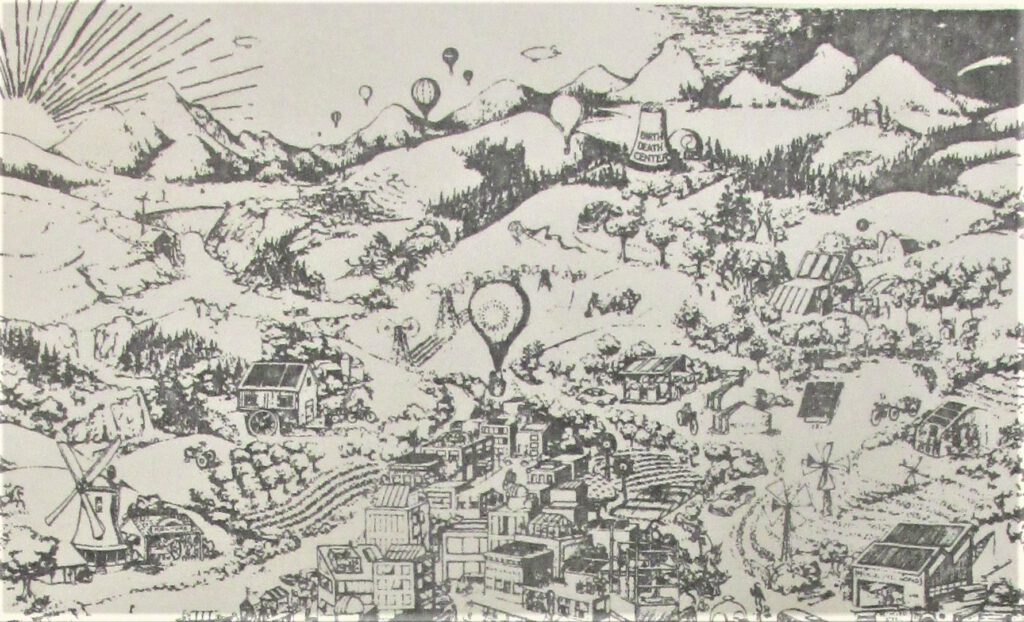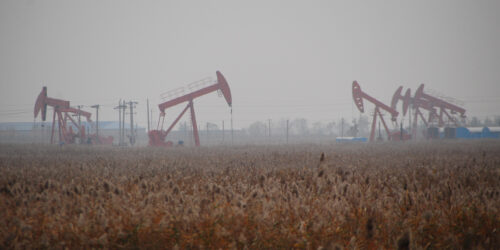Thrifty Housewives and Wicked Wastrels: The Gendered Dimensions of Conservation

This post by Emma Schroeder originally appeared as part of a series on Environmental Histories of the Future on NiCHE, the Network in Canadian History & Environment.
In 1979, members of the York Community Conservation Centre argued that in a conserver society “an ideology could emerge which would serve to keep women out of the workforce and in the home—preserving, recycling, doing more with less.” This “romanticization” of the “the heterosexual nuclear family as a self-regulating and natural unit,” they declared, “does little to excite a feminist imagination of what is possible for women in [the] future.” Without directly addressing the sexual division of labour, they argued that a future environment of resource conservation would only put “a human face on repression.”[1]
The concept of the conserver society was developed by the Science Council of Canada (SCC) in the early 1970s. Its technical report, Canada as a Conserver Society: Resource Uncertainties and the Need for New Technology, did not appear until 1977, but the idea of a conserver society gained public attention in the years preceding its publication. The conserver society differed from other work of the SCC in that, as one reporter noted, “the idea is to be activist.”[2] Workshops, newspaper interviews, radio shows, and the SCC publication Conserver Society Notes explained energy use, recycling, and other conservation strategies to readers. Yet as these women noted, the concept carried with it gender assumptions about women’s role as domestic caretakers. Indeed, public depictions of conservation reified white, heteronormative, middle-class relationships. Such illustrations of feminine household bliss did not sit well with feminists working to overturn women’s social, political, and economic oppression. They saw women’s familial, domestic roles as one of the roots of such power hierarchies, hierarchies that conservation reinforced.
The SCC vision of the conserver society involved changing Canadians from “consumers” into “conservers” so that Canada could lead the way in providing “more equitable distribution of the benefits of natural resources to all mankind.”[3] It was a vision of a future environment that would contain abundant resources, personal fulfillment, and national economic well-being. The concept reflected the historical moment of energy crises, resource scarcity, and international concerns over “limits to growth.” The future environment embodied by the idea of a conserver society also relied, however, on prescriptions for how Canadians should act in the present. As Ursula Franklin, physicist, pacifist, and chair of the Conserver Society Committee, put it to a reporter, the conserver society was “a set of attitudes that I define as Thrifty Housewife.” Only if Canadians assumed a “conserver ethic” and lived accordingly could the promised future world emerge.
Historians have considered the conserver society as an early example of sustainable development and as a program that enabled local environmental groups to expand the scale of their activism. Feminists’ rejection of the conserver society vision, and Franklin’s comments about “thrifty housewives,” suggest that historians should follow Ruth Sandwell’s contention that energy history requires a gendered lens. The history of the conserver society cannot be complete without understanding that many advocates believed that one kind of Canadian—women—bore the responsibility for conservation. According to the Conserver Society Notes, feminine thrift, prudence, and self-control were essential to ensuring resource abundance into the future. Messages from conserver society advocates were aimed at all Canadians, but women, as primary consumers, were central to this resource-use education campaign.

Images throughout Conserver Society Notes implied that conservation practices, such as green roofs and electric vehicles, would not disrupt gendered domestic duties. The first issue depicted the perfect conserver family, complete with a woman cooking and a man relaxing after work. Such illustrations came to life in Canada’s exhibition home, the Prince Edward Island “Ark,” constructed for the United Nations Conference on Human Settlements held in Vancouver in 1976. The “Ark,” intended to house a family of four, contained greenhouses, fishponds, a composting toilet, and various renewable energy sources. Noted by historians either as a political failure or a visionary architectural achievement, at the time government agencies also saw the “Ark” embodying a conserver ethic. A Fisheries and Environment Canada publication, “The Most Prudent Ark,” celebrated the building as a “Conserver Ark,” because it represented prudence, “skill and good judgement in the use of resources.” Prudence, much like thrift, carries with it gendered connotations of women’s correct domestic practices. Images of women washing dishes conveyed the prudent practices of life in the Ark.

Not only were Canadians implicitly assured that conserving practices would not overturn social hierarchies, but people working for the SCC to promote the conserver society went out of their way to make sure women received the right message about conservation. For instance, they informed the editors of Homemaker’s Magazine that interior decoration should not be associated with conservation practices. Rather, they insisted that readers should be informed of the “depletion of resources,” and suggested that the magazine publish an article on the conserver society, featuring an interview with Ursula Franklin.[4]
The gendered dimensions of conservation proved prevalent enough to merit satirical treatment in the popular magazine Saturday Night. Waste, the editor declared, was the “new pornography.”[5] Hot on the heels of women’s liberation, profligate consumption, rather than sexual mores, would mark women’s social transgressions. Tongue-in-cheek articles suggested that the “wicked wasteful woman” was “so careless about conserving, she ought to be walking around with a Scarlet Letter on her chest—not A for Adulteress, but W for Wastrel.” In contrast, the “Conscientious Conserving Woman may look like a latter-day temptress, biting into that apple, but really she’s an angel. She conserves. Constantly. Her kitchen is full of evidence of her honest-to-goodness godliness.”[6] While comical, such depictions indicated the ways conservation dovetailed with a longstanding social construction of women’s domestic work as a moral undertaking.
These public representations of the conserver society seemed to offer women two choices: they could be either consumers or conservers. Some women heard the message that they needed to take responsibility for conserving properly and expressed the burden of doing so. One woman wrote to a newspaper that she could not “begin to tell you the anguish all the recycling and reusing has caused me!” and that her “family complained bitterly about the meals of ‘bulgur wheat and soy grits.’”[7]
Other women, though, rejected the assumptions underlying conservation rhetoric. They argued that conservation itself could not change women’s relationship to oppressive power structures and instead reified women’s domestic duties. They contended that social and political systems, not personal practices, needed to be altered in order to ensure all people had fair and just access to resources.
This political approach to the conserver society began with Franklin herself, who argued for government regulation and corporate responsibility. Pacifism, participatory governance, feminism, and critiques of property relations shaped Franklin’s work. Throughout the 1970s, Franklin continued to be active in the pacifist group Voice of Women’s anti-nuclear campaigns. She encouraged the Voice of Women to expand their activism into critiques of energy infrastructure projects. Rather than focus on changing individuals’ energy consumption, Franklin voiced opposition to pipeline construction through Northern Canada, insisting that “the gain in human community, rather than in gross national product” should be at the heart of deciding where pipelines were built.[8] She was also involved in activism against uranium mining at Cluff Lake.
While engaged in political action to ensure equitable energy infrastructure development, Franklin fielded letters from women trying to understand the impact of the conserver society on women. One woman wrote that she wanted to “know [whether] other women are very concerned and doing something about the pollution problem, energy crisis/waste crisis, etc.”[9] Another invited Franklin to a “one-day symposium dealing with the issue of women and the environments of the present and future” where the group wanted to “specifically address women and their effectiveness in a conserver society, [and] what a conserver society will mean for social and sexual roles.”[10] The question of whether the conserver society could change women’s place in society proved so prevalent that an entire issue of Conserver Society Notes was devoted to finding an answer.

The resounding response from the authors included in “Women and the Conserver Society” was that conservation practices could not adequately address women’s economic and political oppression. Rather than embrace the personal responsibility of conserver housekeeping, authors pointed to structural inequities women faced. They contended that since women were more likely to be impoverished, lack job security, and be single parents, they were more affected by the economic burdens of resource scarcity and energy shortages. One wrote that “women recognize very well that in the current setting, the source of an energy supply is quite independent of their desire to play a fuller role in society.”[11] Another asked “who will be doing the work?” if the conserver society required increased manual labour. [12]
At the end of the 1970s, women argued that providing solar technologies or fuel-efficient vehicles failed to address the political and economic structures that relied on their unpaid domestic work and their underpaid work out of the home. They were not interested in living in a future environment created by “thrifty housewives” prudently saving resources. Instead, they envisioned a future world in which the sexual division of labour had been overturned. Only when freed from domestic duties and familial roles could women assume political, economic, and social power. In the hands of feminist critics, future environments of resource abundance could only take shape through direct political action that addressed social injustices, women’s oppression, and overturned the systems of power that prevented people from creating the future environments that they would want to live within.
[1] A. Hertz, D. Magidson, and J. Wright, “Women in a Conserver Society: Doing More of the Same with Less,” Conserver Society Notes 1, no. 2 (Spring/Summer 1979): 12-13.
[2] Richard Gwyn, “The Road to the Conserver Society,” The Brandon Sun (April 14, 1975), 4.
[3] This comes from SCC Report #19 “Natural Resource Policy Issues in Canada,” quoted in “Implications of a Conserver Society, Paper 2,” Box 28, Folder 2, B1996-0004, Ursula Martius Franklin Fonds, University of Toronto Archives (UMFF-UTA).
[4] Ian Rowe to Jane Hughes, March 14, 1978, B2015-0005, Box 9, Folder 7, UMFF-UTA.
[5] Robert Fulford, “Waste: The New Pornography,” Saturday Night (March 1977): 21.
[6] Marie Kurchak, “Conserving: The New Morality,” Saturday Night (March 1977): 24-25.
[7] Quoted in McLaughlin, “Not an Easy Thing to Implement,” 231-232.
[8] Ursula Franklin, speech to Annual Meeting of the Ontario Voice of Women, May 9, 1970, Box 39, Folder 1, B1996-0004, UMFF-UTA.
[9] Marlene Turner to Ursula Franklin, October 3, 1977, Box 9, Folder 7, B2015-0005, UMFF-UTA.
[10] Joyce DeBoer to Franklin, January 8, 1980, Box 9, Folder 7, B2015-0005, UMFF-UTA.
[11] David Morley, “Reflections on Women’s Liberation and Environmental Conservation in a Time of Societal Crisis,” Conserver Society Notes 1, no. 2 (Spring/Summer 1979): 15.
[12] Hertz et al., “Women in a Conserver Society,” 12.





